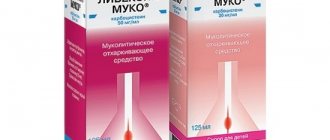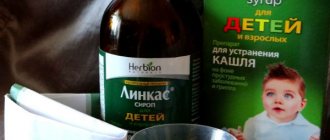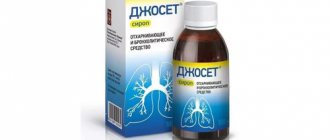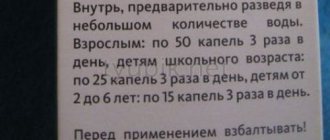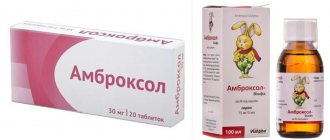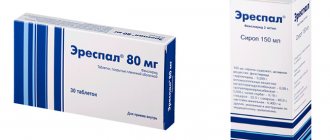Release form and composition
The drug is available in the form of syrup and granules.
Fluifort syrup is available in 100 ml brown glass bottles in a cardboard box. The product comes with a measuring cup and detailed instructions describing the characteristics. The contents of the bottle are a transparent, viscous, dark yellow liquid with a pronounced cherry odor.
100 ml of Fluifort syrup contains 9 g of active ingredient - Carbocysteine lysine salt monohydrate, as well as a number of auxiliary components.
Fluifort granules are intended for preparing a suspension and then taking it orally. Granules are produced in bags of 5 g (10) in a cardboard box with an attached description. The contents of one sachet are light yellow granules with an orange scent. After dissolving the granules in water, we obtain a homogeneous matte suspension with a pleasant taste and citrus smell.
Each sachet contains 2.7 g of the active ingredient - Carbocysteine lysine salt monohydrate. The auxiliary components are citric acid, orange flavor, aspartame, mannitol.
What is Fluifort
This medication belongs to the pharmacological group of mucolytics and has two forms of release - granules for preparing a suspension and syrup for oral administration. In the first case, Fluifort is characterized by a citrus aroma, in the second it has a pleasant cherry taste. A typical medication can be purchased at a pharmacy and is available without a prescription. Approved for use in children and adults, it provides a sustainable therapeutic effect for diseases of the respiratory system. It is important to read the instructions carefully and first consult with an ENT specialist.
Compound
The active substance, carbocisteine lysine salt monohydrate, provides a systemic effect on the respiratory system. As an option, it has a beneficial effect on the production of bronchial secretions, stimulation of sputum production, restoration of the viscous consistency of mucus, and acceleration of the healing process. This drug has proven itself well in modern medicine, since granules and syrup provide stable positive dynamics even for bronchial asthma. Take strictly according to the instructions for use.
pharmachologic effect
The action of Fluifort is due to increased activity of sialic transferase, that is, a special enzyme of goblet cells of the bronchial epithelium that form mucus. The drug helps restore the quantitative ratio of neutral and acidic mucins in bronchial secretions, and also normalizes the viscosity and elasticity of mucus. There is an improvement in the process of sputum discharge.
The medication helps improve the regeneration of the mucous membrane, restore its structure, and stimulate the functioning of the ciliated epithelium. During the use of the drug, the secretion of immunoglobulin A is normalized, the level of sulfhydryl groups in mucus is restored, and mucociliary clearance is normalized.
Fluifort is quite effective against chronic and acute bronchopulmonary pathology. When taken orally, the drug is completely absorbed, and its maximum concentration in the blood and bronchial secretions is observed within an hour. The effect of this product lasts for eight hours.
Fluifort (syrup): instructions for use, analogues and reviews, prices in Russian pharmacies
Fluifort syrup is a mucolytic and expectorant drug for children from 1 year of age. Active ingredient: Carbocisteine.
Normalizes the quantitative ratio of acidic and neutral sialomucins in bronchial secretions: reduces the amount of neutral glycopeptides, increases the amount of hydroxysialoglycopeptides.
Reduces the viscosity of bronchial secretions and discharge from the paranasal sinuses, facilitates the discharge of sputum and mucus, and reduces cough.
Fluifort promotes the regeneration of the mucous membrane, normalizes its structure, reduces the number of goblet cells, especially in the terminal bronchi and, as a result, reduces mucus production.
Restores the secretion of immunologically active IgA (specific protection), improves mucociliary clearance.
Fluifort helps improve the regeneration of the mucous membrane, restore its structure, and stimulate the functioning of the ciliated epithelium. During the use of the drug, the secretion of immunoglobulin A is normalized, the level of sulfhydryl groups in mucus is restored, and mucociliary clearance is normalized.
When Fluifort syrup is taken orally, the drug is completely absorbed, and the maximum concentration in the blood and bronchial secretions is observed within an hour. The action lasts for 8 hours.
Indications for use
What does Fluifort help with? According to the instructions, syrup is prescribed in the following cases:
- bronchial asthma;
- bronchitis;
- bronchiectasis;
- tracheitis;
- tracheobronchitis.
Can be prescribed for diseases of the ENT organs accompanied by the production of viscous mucus:
- otitis media;
- sinusitis;
- adenoiditis;
- rhinitis.
The syrup is prescribed for diseases of the bronchopulmonary system (acute and chronic forms), accompanied by the formation of viscous secretion and difficult to separate sputum.
Instructions for use of Fluifort syrup, dosage
The syrup is intended for children from 1 year to 16 years; after 16 years, Fluifort in granules can be used.
The drug is taken orally, preferably after meals.
Standard dosages of Fluifort syrup, according to the instructions for use, depending on age:
- adults – 15 ml of syrup \ 2-3 times a day;
- children over 5 years old - 5 ml of syrup 2-3 times a day;
- children from 1 to 5 years old - 2.5 ml of syrup \ 2-3 times a day;
The duration of treatment depends on the nature of the disease: 4-6 days for an acute process, 10-30 days for a chronic one. The maximum course is 6 months.
special instructions
The drug is not addictive or dependent. It can be combined with physiotherapeutic procedures.
The syrup contains sucrose, which should be taken into account by patients with diabetes and those on a low-calorie diet.
Antitussives and anticholinergic drugs may reduce the effectiveness of Fluifort.
The drug enhances the bronchodilator effect of theophylline, the effect of antibiotics and glucocorticosteroids.
Side effects
The instructions warn about the possibility of developing the following side effects when prescribing Fluifort syrup:
- belching;
- feeling of heaviness in the stomach;
- nausea;
- abdominal discomfort;
- diarrhea;
- bloating.
As a rule, side effects are mild and disappear quickly when the dosage is reduced.
Contraindications
Fluifort is contraindicated in the following cases:
- peptic ulcer of the stomach and duodenum in the acute phase;
- children under 1 year of age (for syrup);
- children under 16 years of age (for granules);
- I trimester of pregnancy and lactation period;
- phenylketonuria (for granules);
- hypersensitivity to the drug.
Carefully:
- for peptic ulcers of the stomach and duodenum;
- in the second and third trimesters of pregnancy.
Overdose
Leads to increased severity of adverse reactions. There is no specific antidote. Treatment is symptomatic.
Fluifort analogues, price in pharmacies
If necessary, you can replace Fluifort syrup with an analogue of the active substance - these are the following drugs:
- Bronchoboss,
- Fluditek,
- Libexin Muco,
- Fluifort,
- Broncathar.
Syrups with similar effects:
- Fluditek;
- Libexin;
- Mucosol.
When choosing analogues, it is important to understand that the instructions for use of Fluifort syrup, price and reviews do not apply to drugs with similar effects. It is important to consult a doctor and not change the drug yourself.
Price in Russian pharmacies: Fluifort syrup 90 mg/ml 120 ml - from 286 to 345 rubles, cost of granules 2.7 g/5 g 10 pcs. – from 350 to 497 rubles, according to 539 pharmacies.
Store at a temperature not exceeding 25 °C out of the reach of children. The shelf life of syrup is 2 years, granules are 3 years.
Sale in pharmacies without a doctor's prescription.
Source: https://instrukciya-primeneniyu.com/fluifort-sirop/
Indications for use
What does Fluifort help with? Powder and syrup are prescribed for diseases of the bronchopulmonary system (acute and chronic forms), accompanied by the formation of viscous secretion and difficult to separate sputum:
- tracheobronchitis;
- bronchial asthma;
- bronchiectasis;
- tracheitis;
- bronchitis.
The drug can be prescribed for pathology of the ENT organs, accompanied by the production of viscous mucus:
- rhinitis;
- otitis media;
- adenoiditis;
- sinusitis.
Cough powder can be prescribed before diagnostic procedures: bronchoscopy, bronchography.
Instructions for use
Fluifort granules
The drug is taken orally. Adults are prescribed 1 sachet per day. The contents of the sachet should be dissolved in water and mixed before use. The duration of treatment is determined by the doctor (from 4 days to 6 months).
Syrup
The drug is taken orally.
- Children aged 1 to 5 years - 2.5 ml (225 mg) of syrup 2-3 times a day.
- Children over 5 years old: 5 ml (450 mg) of syrup 2-3 times a day.
- Adults: 15 ml (1.35 g) of syrup 2-3 times a day.
The duration of treatment is determined by the doctor (from 4 days to 6 months). In case of impaired liver and kidney function, as well as diabetes mellitus, no dose adjustment is required.
By
Fluifort - official instructions for use, analogues, price, availability in pharmacies
100 ml of syrup contains: Active ingredient: carbocysteine lysine monohydrate (in terms of carbocysteine lysine) 9.0 g. Excipients: sucrose 40.00 g, cherry flavor 0.25 g, methyl parahydroxybenzoate 0.15 g, caramel 0.03 g, purified water up to 100 ml.
Description
A transparent solution of dark yellow color with a characteristic cherry odor.
Pharmacotherapeutic group:
mucolytic expectorant.
Pharmacological properties
Pharmacodynamics Carbocisteine lysine salt restores the viscosity and elasticity of the mucous secretion of the upper and lower respiratory tract. The effect is dose-dependent.
The mucolytic and expectorant effect of carbocisteine lysine salt is due to the activation of sialic transferase (an enzyme of goblet cells of the bronchial mucosa).
Normalizes the quantitative ratio of acidic and neutral mucins in bronchial secretions: reduces the amount of neutral glycopeptides, increases the amount of hydroxysialoglycopeptides. Reduces the viscosity of bronchial secretions and discharge from the paranasal sinuses, facilitates the discharge of sputum and mucus, and reduces cough.
Promotes the regeneration of the mucous membrane, normalizes its structure, reduces the number of goblet cells, especially in the terminal bronchi and, as a result, reduces mucus production. Restores the secretion of immunologically active IgA (specific protection), improves mucociliary clearance and transport of antibiotics.
In addition, carbocisteine lysine salt stimulates the secretion of chlorine ions in the epithelium of the respiratory tract. This phenomenon is associated with the transport of water and, thus, with the liquefaction of mucous secretions.
Carbocysteine lysine salt increases the concentration of lactoferrin, lysozyme and α1-antitrypsin, which indicates the functional restoration of the mucous cells of the bronchial glands and their protein synthesis mechanism.
Carbocysteine lysine salt is a neutral compound (pH 6.8), is highly soluble in water and therefore does not irritate the gastric mucosa, which allows the daily dose to be prescribed at one time.
Pharmacokinetics: Rapidly and almost completely absorbed after oral administration. The bioavailability of carbocisteine lysine salt is low (less than 10% of the dose taken) and does not depend on the dosage form.
The maximum concentration of Cmax in the blood and mucous membrane is achieved after 1.5-2 hours. The plasma half-life is 2-3 hours.
Like all derivatives with a blocked thiolytic group, carbocysteine lysine salt has the greatest affinity for bronchopulmonary tissue. The drug reaches an average concentration in the mucosa of 3.5 mcg/ml with a half-life of about 1.8 hours (2 g daily dose).
Complete elimination occurs after 3 days. Excretion is carried out mainly by the kidneys. Part of the drug is excreted unchanged by the kidneys (30-60%), the rest is excreted in the form of metabolites.
Indications for use
Acute and chronic bronchopulmonary diseases, accompanied by the formation of viscous and difficult to separate sputum (tracheitis, bronchitis, tracheobronchitis, bronchial asthma, bronchiectasis) and mucus (inflammatory diseases of the middle ear and paranasal sinuses - rhinitis, adenoiditis, otitis media, sinusitis), preparing the patient for bronchoscopy or bronchography.
Contraindications for use
Hypersensitivity to any component of the drug. Peptic ulcer of the stomach and duodenum (in the acute stage). Pregnancy (first trimester) and breastfeeding period. Children's age up to 1 year. The drug should not be taken by patients with hereditary disorders such as glucose-galactose malabsorption or sucrase-isomaltase deficiency.
Use during pregnancy and breastfeeding
The use of the drug is contraindicated in the first trimester of pregnancy and during breastfeeding.
Directions for use and doses
Inside. The package comes with a measuring cup with divisions according to the recommended doses. Children from 1 year to 5 years: 2.5 ml of syrup (225 mg) – 2-3 times a day. Children over 5 years old: 5 ml of syrup (450 mg) – 2-3 times a day.
Adults: 15 ml of syrup (1.35 g) – 2-3 times a day. The duration of treatment is determined by the doctor (from 4 days to 6 months).
The indicated dosage is maintained for patients with impaired liver and kidney function, as well as for patients with diabetes.
To open the bottle, press firmly on the top of the cap and turn counterclockwise. After use, screw the cap back on tightly.
Side effects
Experience gained with the use of Fluifort indicates that adverse reactions occur very rarely (frequency
Source: https://medi.ru/instrukciya/fluifort_16401/
special instructions
- In the first days from the start of using the drug Fluifort, the patient’s cough may increase, which is associated with the dilution of sputum and stimulation of expectoration.
- The drug in syrup form should not be prescribed for the treatment of children under 1 year of age, since there is no experience in using the drug and its safety has not been proven.
- Treatment can be combined with physiotherapeutic procedures - inhalations, cupping, massage and others.
- The composition of the drug Fluifort in the form of granules for the preparation of a suspension includes aspartame, so this dosage form is not prescribed to patients with phenylketonuria; it is better to use Fluifort syrup.
- The syrup contains sucrose, which should be taken into account when prescribing the drug to patients with diabetes.
Fluifort side effects
Carbocisteine is characterized by the following rare side effects: gastritis, nausea, diarrhea, dizziness, malaise, skin rash. Carbocysteine lysine salt - rare: epigastric pain, nausea, diarrhea; skin rash.
All of these disorders are transient in nature and disappear after stopping the drug or after reducing the dosage.
If any side effect occurs, you should consult your doctor.
Overdose Currently, no cases of overdose with Fluifort have been reported.
Possible symptoms of overdose: stomach pain, nausea, diarrhea.
Treatment is symptomatic. There is no specific antidote.
Interaction Currently, there are no known cases of interaction between carbocysteine and drugs commonly used in the treatment of respiratory diseases. There was no interaction between the drug and food, as well as substances used for laboratory research. The effect is weakened by antitussive drugs and M-anticholinergic drugs. Increases the effectiveness of glucocorticosteroids (mutually) and antibacterial therapy for infectious and inflammatory diseases of the upper and lower respiratory tract. Enhances the bronchodilator effect of theophylline.
Special instructions From the first days of taking the drug, due to improved secretion removal, the expectorant effect increases.
Fluifort in the form of a granular mixture for oral administration contains the sweetener aspartame. This substance is contraindicated in patients suffering from phenylketonuria.
The use of Fluifort does not lead to addiction or metabolic dependence. Treatment can be combined with physiotherapeutic procedures.
Release form: 5 g of the drug per sachet. 10 sachets of 2.7 g / 5 g in a cardboard box with instructions for use.
Photo of a bag of Fluifort granules
Shelf life of Fluifort granulate is 3 years. Do not use after the date indicated on the package.
Photo of the packaging of Fluifort granules, on which the expiration date is indicated
Storage conditions Store at a temperature not exceeding 25°C, out of the reach of children.
Photo of the packaging of Fluifort granules, which indicates storage conditions
Conditions for dispensing from pharmacies Without a prescription.
Marketing authorization holder Dompe Pharmaceutici S.p.A., Italy
Manufacturing company Dompe S.p.A., Via Campo di Pile - 67100 L'Aquila, Italy
Representative office in Russia CJSC CS LTD 115478, Kashirskoye shosse, 23, House of Scientists of the Russian Academy of Medical Sciences, 2nd floor, room. A. Tel., 324 96 40 fax, 324 55 08
Drug interactions
- The effectiveness of carbocysteine decreases when treated with m-anticholinergics.
- The simultaneous administration of antitussives is unacceptable due to the risk of complications due to impaired sputum excretion.
- A synergistic effect is recorded during treatment with glucocorticosteroids.
- For inflammatory diseases of the respiratory system, Fluifort enhances the effect of antibiotics.
- The bronchodilator effect of theophylline is enhanced by simultaneous treatment with carbocisteine.
Analogues of the drug Fluifort
Analogues of secretolytics and stimulants of motor function of the respiratory tract include:
- Linkas.
- Lazolvan.
- Mukobene.
- Libexin Muco.
- ACC Long.
- Expectorant collection.
- Breast collection.
- Fluimucil.
- Gedelix.
- Solutan.
- Fluditek.
- Dr. Theiss.
- Bronchicum cough syrup.
- Terpinhydrate.
- Flavamed.
- Tussamag.
- Pertussin.
- Bromhexine.
- Travisil.
- Insti.
- Erdostein.
- Tussin.
- Sinupret.
- Ambroxol.
- Bronchicum.
- Pectusin.
- Carbocysteine.
- GeloMyrtol.
- Rinicold Broncho.
- Broncathar.
- Mucosol.
- Bronchostop.
- ACC.
- Solvin.
- Flavamed forte.
- Overslept.
- Fervex for cough.
- Acetylcysteine.
- Ambrobene.
- Gerbion.
- Halixol.
- Zedex.
- Dr. MOM.
- Coldact Broncho.
- Codelac.
- Cough tablets.
- Coldrex broncho.
- Joset.
- Stoptussin.
- Ascoril.
- Mukaltin.

